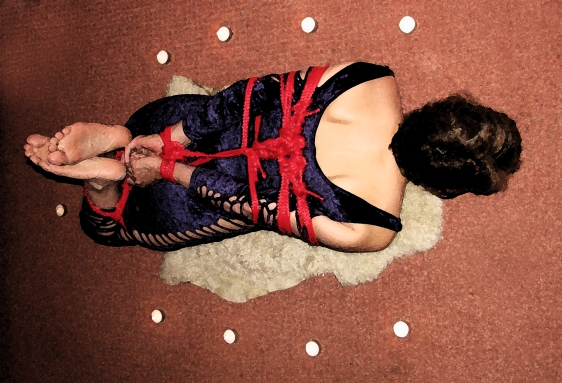On a Pagan camp during the summer I was asked ‘how does it feel?’ right after the question ‘are you OK?’ when the audience (we were doing a demo) saw me flat out, face down, hogtied and very, very quiet.
Very good questions. Of course, I was OK. They laughed when the tone of my reply (‘I’m OK,’) was so obviously one of bliss. And that’s how it felt. My introduction to the world of BDSM at the tender age of forty+ was a bondage demo in a club. A Goth club. I watched a man tying up someone and fancied trying it. I was impressed to see he was monitoring his charge as he progressed with the tying. His approach was safety-led, ensuring no tendons or joints were under too much pressure, that arms and legs were in safe positions and his charge could breathe properly.
So I had a go while friends watched to ensure my safety, as this man was a stranger. The club was packed. Big Goth boots walked around me hogtied on the floor. Goth music blared out loudly. Weirdly in such circumstances I felt…spaced out. It was such a strange feeling. Unexpected but really good. Much better than I’d anticipated. As someone who has done a lot of meditation and has had hypnosis, this felt like some kind of trance. I was blissed out! In the middle of a busy club! I still am not sure why this should be. Is it to do with being swaddled as a baby and being tightly bound made me feel safe? Is it that I had always had to be in control in my daily life as a single mother and business manager, so here was a chance to give up control and relax? I think maybe it’s a little of each.
One thing it wasn’t and isn’t is scary. Fulani was that stranger. He is now my partner. I still enjoy being tied up. He still enjoys doing it. My birthday this year will be special, as we’ve been invited to a Rope Bondage party that very day. Fun! Scary is actually something I like when we’re playing, but bondage alone doesn’t do that. Mind-fucks do that. And they aren’t physically dangerous.
Bondage is only one aspect of BDSM, and it would be a while before I gradually found out about some of its other delights. Fulani has many years more experience than I, and has always treated me with the utmost respect. Our BDSM is a game. We do not ‘live the lifestyle’ that some choose to, but still get a lot out of it in terms of pleasure, as well as it making our relationship stronger. That’s because of the levels of trust involved. Trust is a very important issue when it comes to BDSM. As the submissive, I give my power over to Fulani whenever I put my collar on and we play. If I give him my safeword, I know that he will instantly stop what he’s doing and release me or check with me what’s wrong. This is VITAL. I might feel ill. I might feel upset. I might feel that a rope is too tight or pressing somewhere it shouldn’t. Rope can damage tendons if it presses on them for too long. Your top or Dom needs to know what he/she is doing and be able to correct a problem quickly.
So if you want to try bondage, you should trust the person who is tying you up, be certain they will respect your limits and have a safeword in case you need it for any reason at all. Communicate with your top. Tell them if something hurts when it shouldn’t. Tell them if you suddenly feel scared or upset. Of course, if you are playing with pleasure/pain as well as bondage, ‘ow’ will not suffice. Be specific and say ‘The knot on my wrist is digging in,’ if that’s what’s happening, so he can correct if for you.
But as for how it feels, two people at that demo had a go once I’d been released. They both experienced the same blissful feeling as I did. They had never ventured into the BDSM world before. I can’t guarantee you will but how will you know if you don’t try it? And don’t forget to try something twice, just in case it was done badly the first time!
VelvetTripp






